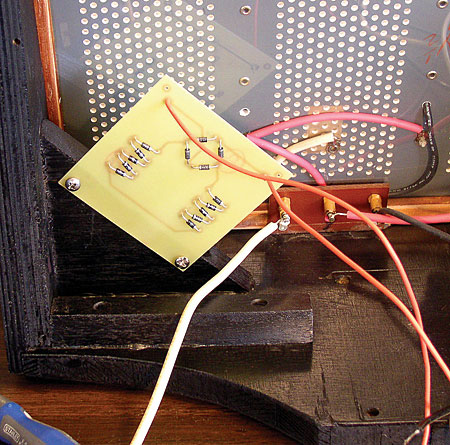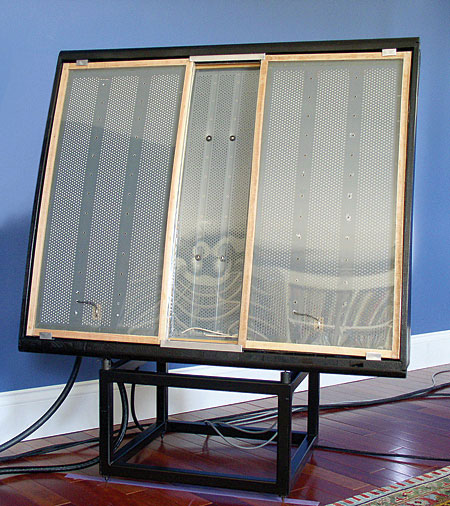| Columns Retired Columns & Blogs |
Listening #43 Page 2
When they arrived two days later, I installed them without modifications, and with only light touches of the soldering iron.
Puttin it back together
Now then: If you've been keeping up, and your enclosure is painted, your bass and treble panels rebuilt or recovered, and your transformer and HT units ready to go, you can start putting things back together. Begin by buying the smallest quantity of self-adhesive felt weather-stripping you can find, and replace the 1" strips of the stuff that used to be behind the upper-right-hand corner of the left-hand bass-panel frame, and the upper-left-hand corner of the one on the right. Then reinstall the four bass-panel retainer brackets.

An early rectifier block alongside the HT unit from which it was removed.
There isn't a best way to put the finished electrostatic panels back in the frame—there's an only way: Select a treble panel and lean it against the inner support struts, taking care not to snag its dustcover on the sharp locator spikes. Now select a bass panel and angle it to the left of the treble panel, sliding its upper and lower edges behind the retainer clips on that side. Then reach around from the rear of the enclosure and push gently toward the front against the outermost edge of its wooden frame, being especially careful not to slip and puncture the dustcover: The idea is to coax the panel into enough of a convex shape that you can then push it all the way to the left, proud of the support ridge. Repeat the process with a second bass panel, for the other side. Then and only then can you reinstall the upper and lower brackets that go in the center, directly in front of the treble panel. If the panels resist your efforts at restoring their curved profiles, you may need a helper to hold the ends of the panels in place while you screw in the screws.

The HT unit, with its sporty new rectifier board, should be wired up before it's bolted down.
Now it's time to wire your ESL back together. Working from the rear, loosely install the HT unit to the right of the support struts—don't bolt it down quite yet—and solder the appropriate lengths of high-voltage hookup wire to the white, red, and black terminals on the two bass panels. (Don't forget your cardboard splash guard.) Solder the red leads to the 6000V tab on the HT unit on the right, and route the white and black wires over to the left side, for eventual connection to the crossover terminals inside the transformer unit. Locate the wires exiting the treble panel, making sure to correctly identify which leads are from the front stator and which are from the rear, and connect the long red wire to the 1500V tab on the HT unit. Solder a long (at least 2') black lead to the ground tab on the HT unit, route it to the left for connection to the internal transformer ground, then bolt the HT unit back into place, making sure to refasten the ESL's bare-wire ground lead to the left-rear bolt from underneath.
Fasten the treble-panel protection circuit you bought in response to my stern advice last month to the corner gusset on the left, making sure to first drill the appropriate pilot holes (the old, dry wood will crack if you don't), twist the two wires together (polarity doesn't matter), and put them alongside all the other remaining wires, all of which are destined for the crossover board. Position the trannie upside-down on the left-hand side, route the wires through its rubber grommet, and solder them carefully to their appropriate terminals, using the notes you made last month or the excellent "over wire" document on Gary Jacobson's website as a guide. (Scroll down to the very bottom, and click on the link for the wiring diagram.) Gently invert the trannie and bolt it down, being careful not to pinch any of the wires, and remember to be sure to fasten the largest eyelet of the bare-wire ground lead to its right-rear bolt from underneath.
A word about wire: I didn't want to use the same dirty old stuff that was in my speakers to begin with, so I took advantage of Philip O'Hanlon's abiding generosity and used some of the nice hookup wire he had left over from his own ESL project. If you want new wire for your Quads, remember that the stuff you buy must be able to conduct very high voltages safely: The hookup wire they stock at RadioShack won't do. If you don't have a friend in the industry, and if for some reason you don't want to buy five 1000' spools of high-voltage wire (one each in white, black, red, blue, and brown), then take a look at the excellent website www.surplussales.com. The last time I looked, they offered 15kV, 18-gauge wire for $2/foot in quantities of between 20' and 100'. The flexible silicone rubber insulation is all white, but you can always color-code the ends with plastic tape.

The protection board, after being screwed to its gusset.
Then get hold of a suitable container—a tumbler will do—and add the following: two ounces of good gin (I like Bombay Sapphire), one-half to once ounce of dry vermouth, two or three teaspoons of juice from a jar of Spanish olives, and a few ice cubes. Stir gently, then pour into a martini glass, using the spoon or your finger to keep the ice cubes from falling in. Garnish with two or three olives on a toothpick and enjoy—and thank God that your speakers are virtually done.
Music, finally
I finished the first speaker of my own pair last Friday. I'd spent the last hours of the day mending errors—I had the HT unit in and out four different times, because I'd left various wires too short—and when I was done, I had to hear it right then and there. I couldn't wait for stereo.
I carried it upstairs from my workshop and set it in the middle of the far end of my music room, more or less in the center of the rug between my Quad ESL-989s. I connected the AC cord to the HT unit, dragged the other end to the wall outlet, and covered my left ear with my left hand and my right ear with my right shoulder while I plugged the plug in with my right hand: Nothing bad happened. No explosions. No fires. I was still alive.
I glanced at the speaker and saw something that made my heart leap with joy: The pilot light was lit.
The preamp was already warmed up, so I connected one of my Lamm ML2.1 monoblocks to the ESL and switched it on: The speaker had been charging for only one minute at this point, but because the Lamm requires at least a minute of warmup before it will play music, I figured that everything would be ready at the same time.
I heard the clunk of the Lamm's relay, and saw its own pilot light glowing steadily: The speaker had been plugged in and charging up for a full three minutes now. I couldn't wait a second longer. I chose a mono CD with trembling fingers—the Lehmann recording of Brahms' Ein deutsches Requiem—and hit Play. I turned up the volume and was encouraged by the complete absence of hum and thunder.
But the sound of the music was awful: nothing below 2kHz. Quieter than it should have been. And when I turned the volume up to a halfway reasonable level, the sound got fuzzy in that Dallas Arbiter Fuzz Face way.
Were my trannie connections bad? Or, worse still, had I fried my bass panels when I replaced their wiring? Oh, shit, shit, shit—it wasn't supposed to be this way. This story was supposed to have a happy ending.
My wife had just come home from work—my daughter was playing in the next room, having sensed that Daddy was more or less incommunicado at the moment—and Janet asked how things were. "Terrible," I said. "I think I've ruined everything." I was this close to crying.
I walked away, but I left the ESL plugged in and the amp powered up. And even as I decided that my grand experiment was a failure, it turned out that my creature was alive after all. I came back half an hour later, took off the Brahms disc, and put on Stereophile's own Test CD from 1990 (Stereophile STPH002-2). God bless Sam Tellig and his rich radio voice: When first I heard him, I thought, This speaker is playing sounds lower than 1kHz!
I skipped ahead to the bass-response tracks and confirmed it: The bass panels were working, all right. They were just taking their own sweet time charging up.

I chose another mono recording: the first Procol Harum album, on Deram. I skipped ahead to "Repent Walpurgis," and just as I did, Janet came back in. The sound was good and getting better by the minute. By the end of it, the bass-panel dustcovers were pulsing in response to B.J. Wilson's kick drum.
That speaker continued to improve drastically: not in that airy-fairy, high-end, "oh, gracious, I hear the air in the corners of the hall resolving itself" way, but in a truly obvious, cartoon-mouse-with-a-stick-of-dynamite, man-on-the-street kind of way. They played louder, cleaner, and with much more bass at 6:30pm than they had at 6pm. And more still at 7pm, and again at 7:30 and 8 and 8:30pm. Regardless of what Quad itself ever said about the ESLs' charging requirements, the sound of that speaker continued to change, drastically, for the better, over the course of more than four hours. It continued to improve more subtly after that.
During the evening of listening that followed dinner, I ran to get my wife three separate times: "Are you hearing this? Are you hearing this? Can you belieeeve this? This is one speaker! This is one speaker that dates from the Eisenhower administration, being driven by a 21Wpc amplifier, and I've never heard anything this good in my life!" She agreed. She agreed.
I played the Dmitri Mitropolous Mahler First, two Bill Monroe bootlegs, and more of the Brahms Requiem. I couldn't believe it. The Mahler in particular was hypnotic: I felt as if I had a music needle in my arm, it was so direct.
And I thought, I'd rather have one of these than two of anything else.
******
When I finished the second ESL, and after I tested it alone, I set them both up as a stereo pair and gave them half a day to charge up. I chose sound quality over safety—an example I hope you'll repudiate, especially if you share your listening space with small children, pets, or the infirm—and left the Quads' protective grilles in the basement, where they remain. Then I played the Heifetz recording of Beethoven's Kreutzer Sonata and I thought: This is why so many people bought two of these things.
After that, I played some of the records I've played at least once a month for 20 years or more, the sounds of which I know almost as well as any sound on earth. Jacqueline Du Pré playing the Elgar Cello Concerto in Kingsway Hall. Arturo Toscanini conducting Verdi's La Forza del Destino overture from studio 8H. Gary Brooker singing "A Salty Dog" in one of the studios at Abbey Road. And I knew that the last time I'd heard any of them sound so true was the last time I'd heard any of them through a pair of Quad ESLs.
- Log in or register to post comments




































